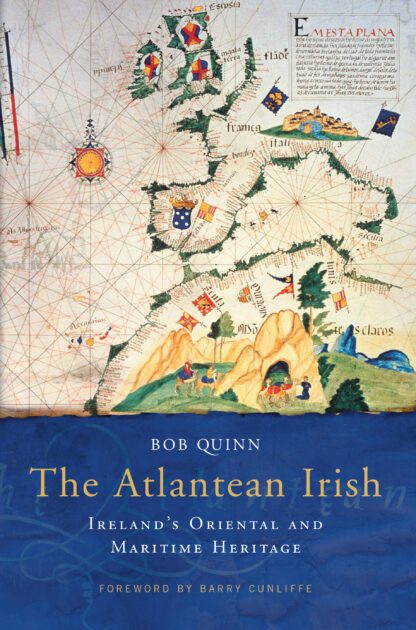
The Atlantean Irish
Ireland's Oriental and Maritime Heritage
By: Bob Quinn
Publication Date: December 2004
€25.00
The Atlantean Irish: Ireland’s Oriental and Maritime Heritage by Bob Quinn
Foreword by Barry Cunliffe, Professor of European Archaeology
Irish identity is best understood from a maritime perspective. For eight millennia the island has been a haven for explorers, settlers, colonists, navigators, pirates and traders, absorbing goods and peoples from all points of the compass. The reduction of the islanders to the exclusive category ‘Celtic’ has persisted for three hundred years, and is here rejected as impossibly narrow. No classical author ever described Ireland’s inhabitants as ‘Celts’, and neither did the Irish so describe themselves until recent times. The islanders’ sea-girt culture has been crucially shaped by Middle Eastern as well as by European civilizations, by an Islamic heritage as well as a Christian one. The Irish language itself has antique roots extended over thousands of years’ trading up and down the Atlantic seaways.
Over the past twenty years Bob Quinn has traced archaeological, linguistic, religious and economic connections from Egypt to Arann, from Morocco to Newgrange, from Cairo and Compostela to Carraroe. Taking Connemara sean-nos singing and its Arabic equivalents, and a North African linguistic stratum under the Irish tongue, Quinn marshalls evidence from field archaeology, boat-types, manuscript illuminations, weaving patterns, mythology, literature, art and artefacts to support a challenging thesis that cites, among other recent studies of the Irish genome, new mitochondrial DNA analysis in the Atlantic zone from north Iberia to west Scandinavia.
The Atlantean Irish is a sumptuously illustrated, exciting, intervention in Irish cultural history. Forcefully debated, and wholly persuasive, it opens up a past beyond Europe, linking Orient to Occident. What began as a personal quest-narrative becomes a category-dissolving intellectual adventure of universal significance. It is a book whose time has arrived.
‘An excellent alternative and radical view of ancient Irish history.’ – Customer review
ABOUT THE AUTHOR
BOB QUINN, writer, photographer, film-maker and television director, is a member of Aosdana and has lived in Conamara in the West of Ireland since 1970. He is author of Sit Down and Be Counted (1969); Smokey Hollow (1991), a fictional memoir; An Tir Aneol (1995), a photographic record of Conamara; and Maverick (2001), a critique of modern broadcasting.
| ISBN | 9781843510246 |
|---|
| Weight | 0.625 kg |
|---|---|
| Dimensions | 235 × 155 mm |
| Publication Date | December 2004 |
| Format | Paperback, 272pp |
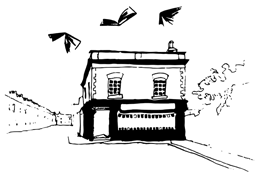
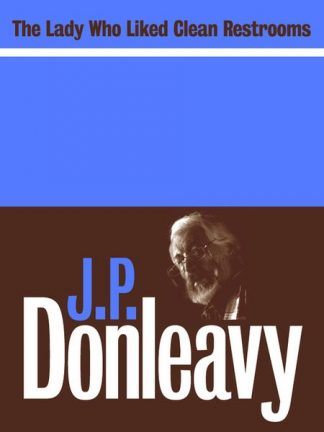
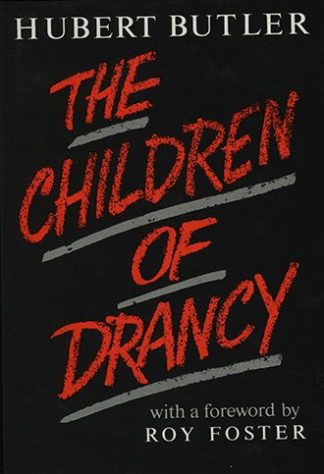
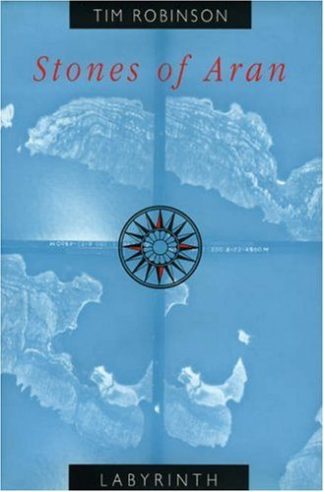
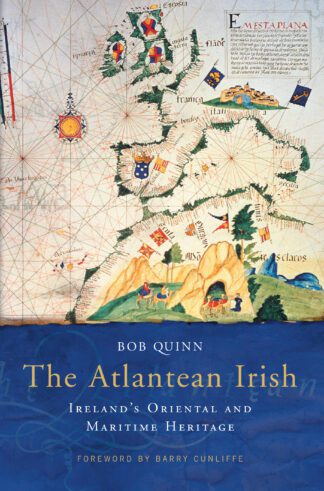
Lilliput Press –
“Barry Cunliffe, John Collis, Simon James, Bryan Sykes, and Stephen Oppenheimer all further ideas that Quinn proposed over two decades ago in film and print. This book revises and expands his thesis. Readers intrigued by more recent DNA, archeological, and linguistic discoveries in Ireland and Britain should read this exciting, if rather rambling, argument for Irish settlement and cultural influences coming not from across the Continent from a La Téne central hub, but from Mediterranean and Iberian sources via travels along the “Atlantic fringe” up the coastlines. (I review Sykes “Seven Daughters of Eve” and “Blood of the Isles” and Oppenheimer’s “Origins of the British,” all of which should have acknowleged Quinn, on Amazon; the following review I wrote in 2005 before “Blood” & “Origins” were published.)
Bob Quinn confronts received knowledge and upends the status quo. Living in a Conamara gaeltacht since 1970, his adopted locale inspired him to ask two questions that impelled the saga adapted in this update (Dublin: The Lilliput Press, 2005, 20 euro) to his 1986 work, Atlantean. Bono, in an interview with Bob Dylan, cited Quinn’s initial contention: tracing ancient Gaelic song to North Africa. A new edition’s range of illustrations, attractive font and design, and incorporation of material gleaned from refinement and elaboration of his initial foray into largely uncharted intellectual waters presents iconoclasts with a model of how to construct an alternative to what everyone assumes to be the only way from which to perceive ‘reality.’
Looking at the púcán boats that once dotted his Atlantic coast, he noted their resemblance to lateen sails on Egyptian dhows; listening to sean-nos melodies, he marvelled at their pentatonic counterparts from the Arab realms. Quinn targets cultural echoes, archaeological evidence, and linguistic links tying Ireland not to the conventional La Tene-Celtic and thereafter European-centered diffusion pattern, but to a neglected nautical passage that, he reasoned, had long escaped the gaze of Continentally ethnocentric scholars fixated on an Indo-European genesis for the peoples and crafts that entered into the island. Now, Quinn’s thesis contradicts the Celtic origins which many Irish have celebrated for 300 years.
His findings, necessarily scattershot and rather random, resemble a Victorian vicar’s parlour-displayed assemblage of bric-a-brac. (Only source titles, not precise citations, fill his endnotes, frustratingly.) I suppose Quinn might retort it’s instead structuralist bricolage, a bold thrust to delve deeper below the psuedo-Keltic veneer appliqued by Revivalists and Romantics to excavate the broken shards and ghostly palimpsests abandoned by those who travelled the “wine-route” from as long as 5000 BCE along the Southern Mediterranean littoral, until, drawn by tin from Cornwall and smugglers to Ireland, moving up the Iberian coasts until they continued due north to the first landfall the western and southern island shores. He advances that the true impetus for Irish culture came from North African, Egyptian, and Mediterranean lands rather than Central Europe, the Roman empire, and its successors.
Neither the ancient classical nor the native Irish authors, Quinn insists, called the indigenous people in our island ‘Celts’ — this being an antiquarian and so relatively early modern coinage. In what was for me the most intriguing section of his study, he contends that North African substrata underlie our Irish language itself, and he relates the legendary accounts of the Iberian and Egyptian origins of the island’s first ancestors to the migrations that would have brought trade, colonisers, refugees from early Christian persecutions, and monks to Ireland before the suspect arrival of a largely fabricated Patrick. While I lack the familiarity that Quinn has with his many sources, I wondered why, however, his use of mitochondrial DNA studies to support his claims cited Bryan Sykes (his eloquent Seven Daughters of Eve. London: 2001) of Eve, but not the concurrent team led by David Bradley from TCD, whose assertions a few years back in Science appear to complicate what Quinn simplifies about the coming of the earliest settlers from Asia Minor to Connaught thousands of years ago, Bradley’s team, and other research by Brian McEvoy and colleagues at TCD, and by D.B. Goldsmith and colleagues, also depends on genetic markers still overwhelmingly present in natives to the West today. None of these researchers, active in the past decade, have been cited by Quinn, an obvious flaw.
But maybe Quinn’s stacking his evidence? Bradley’s TCD team and recent geneticists argue for an Atlantic fringe origin, but from Northern Spain to Scandinavia rather than further south and east. Simon James and Barry Cunliffe, among other leaders in pre-Roman Celtic-British studies, have accepted the invalidity of the “Celtic” invasion of the islands and the west thesis. Emerging challenges by linguists to the Central European genesis and Celtic invasion pattern seem to clash in their findings with Quinn’s Mediterranean-African genesis for the early Irish.
Bearing the traces of peoples pushed ever westward as farmers advanced, a kilometer or so a year, the peoples (whose genetic traits distinguished at 97% in the West of Ireland among males of native descent vs. 3% in today’s Turkey) came not over water but presumably over land–driven across Europe as they were pushed ahead by agriculturalists—unsettled folks from the Fertile Crescent who were shunted ever westward as farmers ploughed Europe over thousands of years. The remnants of those pre-farmers wound up settling finally into Connacht’s spaces–the last nearby refuge on the North Atlantic fringe.
Again, certain portions of Quinn’s argument, even to this general reader, appear akin to romanticised notions of solidarity with au courant Arab and Third World solidarity rather than the ‘Thomas Cook model’ of radial diffusion from an Alpine or Danubian homeland, favored by many 19 and 20c scholars. The evidence, as Quinn admits at times, for a maritime rather than continental dependence influencing Irish development depends far too often for academic scrutiny upon perhaps coincidental or random findings, albeit painstakingly and cleverly compiled by Quinn over three decades and more. His basic reliance upon his interpretation of Irish from its status as a living language rather than using Romanised inscriptions to re-create a Celtic tongue appears convincing, and I await further scholarship to clarify Quinn’s educated guesses. Like the vicar, his collection impresses somewhat but also leaves the viewer muddle-headed as he examines many labels, evaluations, and connections between displays.
Chapters on Wales, Vikings, and Sheela-na-Gigs sway uneasily beside steadier accounts of monastic art, mythmaking, and the pirate trade with Algiers and Morocco. The Berber-Irish parallels again smack of the type of overly enthusiastic detective fieldwork that Lorraine Evans (Kingdoms of the Ark. London: Pocket Books, 2001) presented in establishing archaeological patterns making Queen Scota of Milesian lore into the eponymous ruler over Ireland’s hordes and the instigator of the British race. I enjoyed both Evans and Quinn’s attempts to scour the taint of British Israelitism off of their navigational tools, and I wondered why the latter author neglected the former, but I fear that those hidebound and tenured will publish on largely unconvinced by either freelancer’s revolutionary reports.
Frustration emerges as Quinn recounts throughout his revised work the skepticism he faced from this establishment. Re-orientalists, as I term Quinn and Evans, preach to British and Irish audiences that their ‘myths of origin’ need not be based in a proto-Brussels conclave.
Many today, in classrooms and libraries, may not pay much attention to such independent scholars and thinkers. Yet, I applaud Quinn in that he speaks boldly from his own, equally defensible, certainly progressive, sea-ready fastness. If we descended from the Atlantic fringe under a Celtic heritage, we can then boast our descent from Atlanteans!
Revised from a review in the Belfast on-line journal The Blanket, “Re-orienting perspectives,” March 2005.
Anyone driving from Galway city through to, say, Carna, might agree with Quinn. You hug the sea more than the mountain in drawing your bearings, your domain, and your living. Its towns and enterprises meet the needs of those traditionally travelling by huicear and not Honda, currach and not Cortina. Commonsense shows, in what Quinn should have displayed with localised and more modern archaeological maps, that from Neolithic times contacts can be charted drawing the West and South of Ireland into Spanish ports and settlement and trade more than European markets. For all the willful and accidental vagaries within Quinn’s spirited and never less than readable chapters, this author takes on the ‘Celtic’ giant and chops his Irish progeny down to a less Eurocentric, more portable and shipworthy size. From the Arabic term for any trefoil, by the ways Quinn unveils, we import shamrakh.” JOHN MURPHY
Lilliput Press –
“It is to be recognised firstly that the Author of this book carried out a daunting level of research, in the true meaning of the word. From Egypt to Connemara, over decades, he has tracked down a volume of pre-Celtic connections to Ireland. It is clear that his research rests on very broadly based, earlier studies. The academic mastery, shown in this labour of love, makes the book important reading on ancient history and on the meaning of ‘Celtic’ in Ireland. Ádh mór.”
Lilliput Press –
“Anyone who still believes in the “Celtic” myth of Irish origins should read this book. The “Celts” are a Victorian fabrication, a myth designed to prove that the Irish were an “aryan race”. Ireland’s links to North Africa go back to at least the Bronze Age, when Phoenician merchants probably traded with locals for the copper mined at Mt. Gabriel. It is bizarre that this idea should still be considered controversial by most archaeologists in Ireland, when the Phoenicians are known to have traded for Cornish tin. Evidence is piling up in favour of Quinn’s theory of close links between the Coptic church in North Africa, and the early Christian church in Ireland, most recently in the discovery of Egyptian papyrus in the lining of the Faddan More Psalter!” CIARAN
Lilliput Press –
“Bob Quinns book is most successful at debunking the myth that the Irish are one homogonous “Celtic” people. He pulls apart the stagnant orthodoxy that is the study of early Irish history and breaths new life into the area. He charts the developement of Irish culture, through our Maritime past, our linguistic and culural History along the atlantic Seabord to the Iberian peninsula and North Africa. A real kick in the teeth to racists and those who claim the Irish as a “European” Indo-European or Aryan “Race”.” MARK HOSKINS
Lilliput Press –
“Bob Quinn’s book and documentaries are unique – an Irishman who completely rejects the title “Celt” – The beauty of Quinn’s work is his journey of discovery. The Irish never called themselves Celts – it was the cabal in London that devised a plan to hide the true history of the Gaels.
Something deep inside Quinn rejects the imposed colonial identity – He leaves Dublin and moves to Conamara – to the western edge of Ireland. His independent mind and character – unchanged – while Bono shape-shifts at every opportunity – it is only Bob Quinn that remains true – He is one man who you can’t buy – a rare character – his films and book reflect something that the British Empire has been trying to9 hide for centuries.
A Cross with Bismillah (in the name of Allah); Sean Nos compared to the Azzan, a langauge touched by Hamitic and Semitic – beautiful – A thousand years ago the two most civilised nations were Ireland and Moorish Spain.” IBRAHIM ALI
Lilliput Press –
“An excellent alternative and radical view of ancient Irish history tracing its connections with its true non-Celtic roots in north Africa & the Phoenicians.
Quinn is a great advocate of a different view of Irish history & has produced an excellent work with a wealth of research, some of it personal.
It is becoming the case that if you want to get to the roots of Irish history you have to go outside the academic mainstream to enthusiasts like Quinn. Mainstream academia is now so afraid of unconventional history that what many academics produce is so tame & unchallenging.
Quinn shows quite clearly that the Irish are not Celts &, through the Atlantic highway, are far more closely connected to north Africa & Spain than Britain or Rome.
The question arises in my mind then is that if the Irish were so closely linked to the Phoenicians & the Moors why these great empires along with Rome, never conquered Ireland & were content to simply trade with them? Was it the case that Ireland was not the barbaric outpost passively soaking up influences from around the known world as suggested by so many – including Quinn – but was a mighty sea power that could resist all the great empires until the Anglo-Normans somehow over came them in the 12th centuryAD.
Its time to move this discussion on of an alternative view of the Irish and address the issue of Ireland’s undoubted ability to resist great empires. Its not good enough any longer to suggest that the everything in Irish history & culture came from abroad. It is insulting & quite frankly racist to suggest that everything good in Irish culture did not originate with the Irish.
How come Newgrange in Ireland preceded the Pyramids & no one thinks that the Irish just might have influenced the ancient Egyptians!? Or maybe the Irish built the pyramids, like they built early European Christianity!? Crazy eh?
What if the influencing went the other direction from west to east & what if Quinn & others are looking through the wrong end of the telescope?”